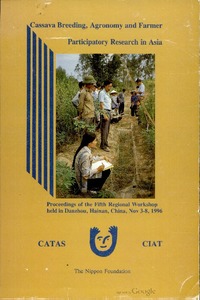Trends, constraints and opportunities of the Asian cassava sector: An assessment
This paper attempts to utilize past cassava production, utilization and market trends, integrated with regional macro-economic developments, together with a general summary of current cassava R&D advances, to analyze the principal cassava sector constraints and future opportunities, both at the country and regional level.
The first section shows where the major cassava production and utilization areas are and secondly assesses cassava area, yield and production trends from 1980-95 by region and specific countries (cases), explaining past trends due to a variety of factors, including climatological, biological, technological (R&D), political and macro-economic aspects.
The second section concentrates on the dynamics of cassava processing, products and markets, analyzing the major cassava product groups, i.e. cassava for fresh direct consumption, flours, dried cassava chips and pellets for animal feeds, and cassava starches. Evidence will be presented to show the significant increases of starch production versus relative declines in pellets. Macro-policy changes, expanded market demand, technology advances and relative price changes are some of the major factors explaining these recent developments.
The third section of the paper assesses regional, market (and country) cassava sector constraints which are stratified into four areas: (a) biological/technical aspects, (b) socio-economic aspects, (c) institutional aspects, and (d) political aspects. For some of the aspects quantitative evidence is presented; other aspects are more qualitatively assessed. After this, the most significant future opportunities are analyzed. These are grouped into three areas: (a) technological, (b) market, and (c) institutional/political.
The paper ends with the major conclusions and makes several recommendations.

